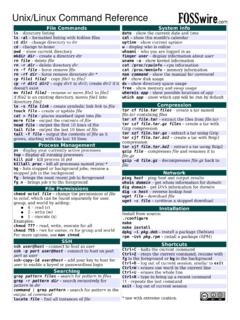Transcription of Russ Cox Frans Kaashoek Robert Morris August 31, 2020
1 Xv6: a simple, unix -like teaching operating systemRuss CoxFrans KaashoekRobert MorrisAugust 31, 20202 Contents1 Operating system and memory .. and File descriptors .. system .. world .. 202 Operating system physical resources .. mode, supervisor mode, and system calls .. organization .. : xv6 organization .. overview .. : starting xv6 and the first process .. world .. 283 Page hardware .. address space .. : creating an address space .. memory allocation .. : Physical memory allocator .. address space .. : sbrk .. : exec .. world .. Exercises .. 394 Traps and system trap machinery .. from user space .. : Calling system calls.
2 : system call arguments .. from kernel space .. exceptions .. world .. 485 Interrupts and device : Console input .. : Console output .. in drivers .. interrupts .. world .. 536 conditions .. : Locks .. : Using locks .. and lock ordering .. and interrupt handlers .. and memory ordering .. locks .. world .. 647 .. : Context switching .. : Scheduling .. : mycpu and myproc .. and wakeup .. : Sleep and wakeup .. : Pipes .. : Wait, exit, and kill .. world .. Exercises .. 798 File .. cache layer .. : Buffer cache .. layer .. design .. : logging .. : Block allocator .. layer.
3 : Inodes .. Code: Inode content .. Code: directory layer .. Code: Path names .. File descriptor layer .. Code: system calls .. Real world .. Exercises .. 969 Concurrency patterns .. patterns .. locks at all .. 10210 Summary10356 Foreword and acknowledgmentsThis is a draft text intended for a class on operating systems. It explains the main concepts ofoperating systems by studying an example kernel, named xv6. xv6 is modeled on Dennis Ritchie sand Ken Thompson s unix Version 6 (v6) [14]. xv6 loosely follows the structure and style of v6,but is implemented in ANSI C [6] for a multi-core RISC-V [12].This text should be read along with the source code for xv6, an approach inspired by John Li-ons Commentary on unix 6th Edition [9].
4 Pointers to on-line resources for v6 and xv6, including several lab assignments using have used this text in and , the operating systems classes at MIT. We thank thefaculty, teaching assistants, and students of those classes who have all directly or indirectly con-tributed to xv6. In particular, we would like to thank Adam Belay, Austin Clements, and NickolaiZeldovich. Finally, we would like to thank people who emailed us bugs in the text or sugges-tions for improvements: Abutalib Aghayev, Sebastian Boehm, Anton Burtsev, Raphael Carvalho,Tej Chajed, Rasit Eskicioglu, Color Fuzzy, Giuseppe, Tao Guo, Naoki Hayama, Robert Hilder-man, Wolfgang Keller, Austin Liew, Pavan Maddamsetti, Jacek Masiulaniec, Michael McConville,m3hm00d, miguelgvieira, Mark Morrissey, Harry Pan, Askar Safin, Salman Shah, Adeodato Sim ,Ruslan Savchenko, Pawel Szczurko, Warren Toomey, tyfkda, tzerbib, Xi Wang, and Zou you spot errors or have suggestions for improvement, please send email to Frans Kaashoekand Robert Morris 1 Operating system interfacesThe job of an operating system is to share a computer among multiple programs and to provide amore useful set of services than the hardware alone supports.
5 An operating system manages andabstracts the low-level hardware, so that, for example, a word processor need not concern itselfwith which type of disk hardware is being used. An operating system shares the hardware amongmultiple programs so that they run (or appear to run) at the same time. Finally, operating systemsprovide controlled ways for programs to interact, so that they can share data or work operating system provides services to user programs through an interface. Designing a goodinterface turns out to be difficult. On the one hand, we would like the interface to be simple andnarrow because that makes it easier to get the implementation right. On the other hand, we may betempted to offer many sophisticated features to applications. The trick in resolving this tension is todesign interfaces that rely on a few mechanisms that can be combined to provide much book uses a single operating system as a concrete example to illustrate operating systemconcepts.
6 That operating system , xv6, provides the basic interfaces introduced by Ken Thompsonand Dennis Ritchie s unix operating system [14], as well as mimicking unix s internal provides a narrow interface whose mechanisms combine well, offering a surprising degreeof generality. This interface has been so successful that modern operating systems BSD, Linux,Mac OS X, Solaris, and even, to a lesser extent, Microsoft Windows have unix -like xv6 is a good start toward understanding any of these systems and many Figure shows, xv6 takes the traditional form of akernel, a special program that providesservices to running programs. Each running program, called aprocess, has memory containinginstructions, data, and a stack. The instructions implement the program s computation. The dataare the variables on which the computation acts.
7 The stack organizes the program s procedure given computer typically has many processes but only a single a process needs to invoke a kernel service, it invokes asystem call, one of the calls inthe operating system s interface. The system call enters the kernel; the kernel performs the serviceand returns. Thus a process alternates between executing inuser spaceandkernel kernel uses the hardware protection mechanisms provided by a CPU1to ensure that each1 This text generally refers to the hardware element that executes a computation with the termCPU, an acronymfor central processing unit. Other documentation ( , the RISC-V specification) also uses the words processor, core,and hart instead of : A kernel and two user executing in user space can access only its own memory.
8 The kernel executes with thehardware privileges required to implement these protections; user programs execute without thoseprivileges. When a user program invokes a system call, the hardware raises the privilege level andstarts executing a pre-arranged function in the collection of system calls that a kernel provides is the interface that user programs see. Thexv6 kernel provides a subset of the services and system calls that unix kernels traditionally lists all of xv6 s system rest of this chapter outlines xv6 s services processes, memory, file descriptors, pipes,and a file system and illustrates them with code snippets and discussions of how theshell, unix scommand-line user interface, uses them. The shell s use of system calls illustrates how carefullythey have been shell is an ordinary program that reads commands from the user and executes them.
9 Thefact that the shell is a user program, and not part of the kernel, illustrates the power of the systemcall interface: there is nothing special about the shell. It also means that the shell is easy to replace;as a result, modern unix systems have a variety of shells to choose from, each with its own userinterface and scripting features. The xv6 shell is a simple implementation of the essence of theUnix Bourne shell. Its implementation can be found at( :1). Processes and memoryAn xv6 process consists of user-space memory (instructions, data, and stack) and per-processstate private to the kernel. Xv6time-shares processes: it transparently switches the available CPUsamong the set of processes waiting to execute. When a process is not executing, xv6 saves its CPUregisters, restoring them when it next runs the process.
10 The kernel associates a process identifier,orPID, with each process may create a new process using theforksystem a new process,called thechild process, with exactly the same memory contents as the calling process, calledtheparent in both the parent and the child. In the parent,forkreturns thechild s PID; in the child,forkreturns zero. For example, consider the following program fragmentwritten in the C programming language [6]:int pid = fork();if(pid > 0){printf("parent: child=%d\n", pid);10 system callDescriptionint fork()Create a process, return child s exit(int status)Terminate the current process; status reported to wait(). No wait(int *status)Wait for a child to exit; exit status in *status; returns child kill(int pid)Terminate process PID.}
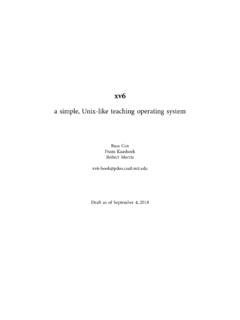

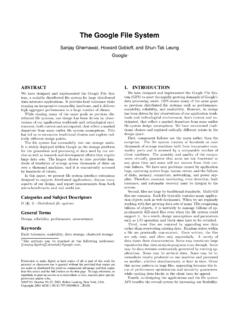

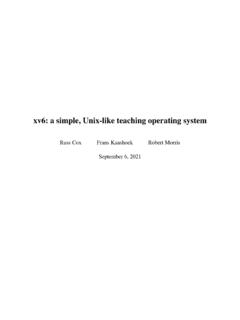
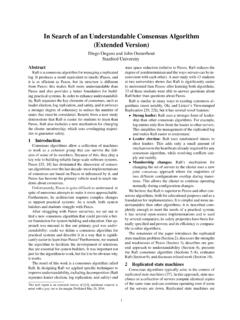
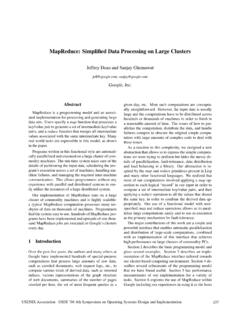
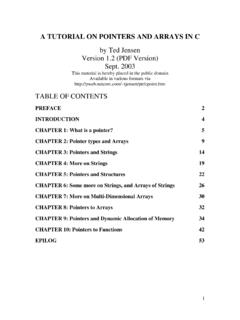

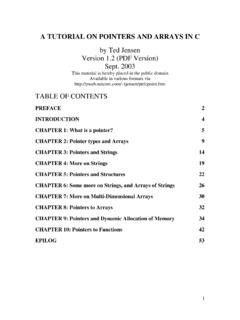
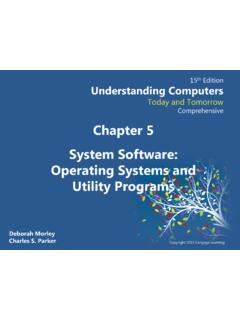

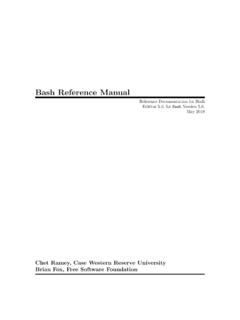
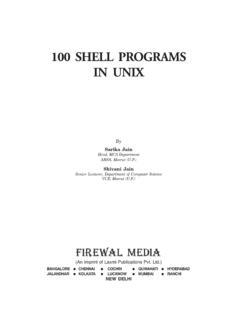


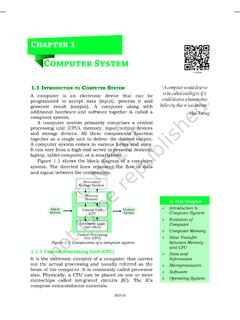
![Unix Commands [pdf] - CMU](/cache/preview/1/9/d/8/8/7/a/6/thumb-19d887a6549337a2512a4a299b61c163.jpg)
